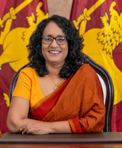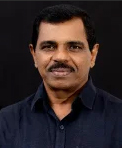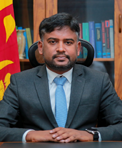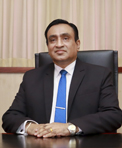Ministry of Education Overview
The Scope
Unveiling the child friendly, quality primary and secondary educational opportunities and the excellent higher educational opportunities based on innovations through sustainable educational strategies for the promotion of Sri Lankan citizens up to a social and economic development level based on the knowledge.
Tasks and Duties
Providing policy guidance to the relevant sections and other affiliated institutions for creating “a society complete with knowledge” founded upon the national policies expected to be implemented by the government, formulation of policies related to the subject of education in accordance with the stipulated laws and regulations, implementation of the projects coming under national budget, state investments and national development program and the implementation of policies, programs and projects related to the subjects and duties of the departments, state corporations and statutory bodies coming under the ministry, follow up activities and evaluation.
Performance of tasks necessary for the implementation of national education policies recommended by the National Education Commission for the purpose of education reforms.
Vision
To reach excellence in global society through competent citizens who share the Sri Lankan identity
Mission
Develop competent citizens keeping with the global trends through innovative and modern approaches to education leading to efficiency, equity and high quality performance ensuring stakeholder satisfaction
Historical Evolution of Education
The ancient tradition of learning
ln the ancient times, following on the lines of eastern traditions, learning was considered a valued treasure. Men of learning were highly respected and royal patronage was extended to great teachers, poets and men of letters.
In a society where printing was not known, transmission of knowledge was handed down the generations through word of mouth, the oral tradition. ligious knowledge and philosophy of Buddhism were encapsulated in to short stanzas which were memorized by the pupils, who were trained to expand the kernel into detailed exhortations when preaching to the people.
Later the texts were committed to writing in Ola leaf manuscripts and these were stored in the libraries of temples. There were great seats of learning comparable to present day universities, run by the clergy where religion, philosophy and literature were taught.
The Pirivenas or monastic colleges, primarily intended for the clergy, also had lay students. There were a number of such monasteries in the capital city where large numbers of priests learned Buddhism, languages, grammaIrhetoric and allied academic disciplines. The literary works produced in the latter part of the Anuradhapura period, in Sinhala, written in Ola manuscripts, show a high quality of literary excellence.
Unfortunately, the knowledge in technology has not been committed to writing and is lost to the future generations. However, the ancient religious edifices and the irrigation system with large reservoirs and canals is testimony to a high level of engineering knowledge that the ancients possessed. Foreign invasions and natural disasters led to the drift to the south west, abandoning the ancient centres of civilization.
Information about Hindu educational traditions is meagre. There would have been temple schools based on eastern tradition in the Tamil settlements in the north. These would have been modernised during the time of the Portuguese and Dutch rule.
The Muslim settlements came up much later when the Arabs came as traders in large numbers and settled down after the 15thcentury. In these settlements there were learning centres attached to mosques where the recitation of the Quran was practiced.
Advent of Western Influence
The Portuguese arrived in 1-505 and captured the maritime provinces of the country. They ruled these areas for 1-50 years while the Sinhala kingdom survived in the central highlands. Thereafter; the Dutch succeeded the Portuguese and after another l-50 years the British took over. Two decades after their capture of the maritime provinces, they were able to subjugate the king of Kandy and bring the whole island under their rule. Their rule lasted till 1948 in which year the country gained independence.
Under the Portuguese, education was in the hands of the missionaries who established schools to propagate the Roman Catholic religion. Different orders of the church, the Franciscans, Jesuits, Dominicans and Augustinians arrived in the island and zealously organised parish schools where reading writing and scriptures were taught. The medium of instruction in these schools was the mother tongue. Elementary education was provided to all children in the parish, while the secondary schools enrolled only the children of Portuguese civil and military officers or local chieftains. The secondary school curriculum in addition to reading, writing and scriptures had humanities and rhetoric.
The Dutch who succeeded the Portuguese, discovered that the establishment of schools greatly assisted in the work of civil administration and trade. They followed rigorous policy to expand education and the number of schools and the pupils increased rapidly. Due to the suspicion that Catholics would support the Portuguese, they followed policy of suppressing Catholicism and promoting the Dutch Reformed Church. However, they did not leave education in the hands of the clergy and the government exercised a fair degree of control over the running of schools. They appointed a Scholarchal Commission to supervise schools in each district.
The British, who succeeded the Dutch, laid the foundation for a mass education system during the 19th century. To begin with, the clergy were encouraged to establish schools with government assistance. Latel influenced by the Humanitarian movement in England and also realising the need to educate the natives, to man the lower level positions in the public service and the emerging commercial plantation sector, the government started supporting education. A dual system of schools, those run by the denominational bodies with government assistance, of which some were following the English medium and also charging fees and others run by the government as state schools in the mother-tongue for the children of common people, emerged. With the increase in the number of schools, the government established the Department of Public Instruction in 1869 and it was entrusted with the task of managing the government schools and regulating the assisted schools in order to ensure that standards were maintained. The government increasingly realised its duty of providing a basic education which helped to combat crime.
The national re-awaking
By the dawn of the 20th century there was a national revival among the Buddhists and the Hindus. Influenced by the developments in India and international events such as the defeat of Russia by Japan in 1905, the emerging local middle class under the commercial economy, became conscious of their national heritage and the need for a struggle for greater freedom from colonial rule. They had received a liberal education in the public schools and subsequently in higher education institutions in England. The Buddhist leaders formed the Theosophical Society to establish schools with a Buddhist environment while the Hindu leaders established the Hindu Association to establish schools for Hindu children. As a result, the number of assisted schools expanded rapidly.
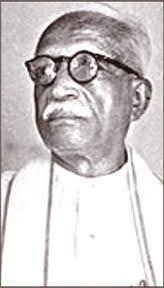
Dr. C.W.W. Kannangara
1912 – 1978
The dawn of a new era
The spurt in education which propelled Sri Lanka to achieve a high level of social development began even before the country”\ gained independence. Dr C.W.W. Kannangara The Donoughmore Constitution n (1931-1947) which granted Sri Lanka a status of semi-independence provided the opportunity for laying down a firm foundation in social development. Dr. C.WW. Kannangara who held the portfolio of education during this whole period is one person responsible for initiating a series of educational reforms that created a lasting influence on the history of education in this country. The expansion in the provision of education, enactment of comprehensive law on education, grant of free education from the kindergarten to the university, establishment of central schools, change in the medium of instruction to national languages, curricular changes and student welfare measures such as bursaries for promising students from disadvantaged families and free midday meal for schoolchildren were all his proposals. lt is said that he left, “education which was the patrimony of the rich as the heritage of the poor”.
The thinking of Dr. Kannangara formed the basis and guide to action for policy makers in the post-independence era. The post-independence period is marked by further growth in education establishing a network of schools spread throughout the country.
The take-over of schools in 1-960-61 is another landmark towards establishing a national system of education. The establishment of schools had been carried out by denominational bodies in competition which resulted in lack of planning, duplication and waste of resources. With this legislation except for a small number of schools the vast majority came under government control and a fair degree of rationalisation has been made possible.
Student welfare services too expanded during this period. In addition to school midday meal and scholarships, textbooks and a set of uniforms is being supplied and school transport is subsidised by the government.
Another area that received the attention of the education authorities during this time was curriculum development. The Curriculum Development Centre (CDC) was established in the 1960s mainly to develop curricula in science and mathematics. Later it took over the development of curricula in all subjects and helped in teacher development as well. In 1985 the National Institute of Education (NlE) was established by an Act of Parliament not only to carry forward the function of curriculum development but also to award degrees in education for the professional development of teachers, principals and educational administrators.
Teacher development is another area of concentration by the educational authorities. The establishment of National Colleges of Education (NCoE) (1986) recognised the importance of pre-service training of teachers. L7 NCoEs were established with all the facilities to train the teachers required for schools. In addition, 100 Teacher Centres (TCs) were established to provide in service training for teachers.
The National Education Commission (NEC) was established by an Act of Parliament in 1991 as the body that would formulate national policy on education. The Commission is appointed by His Excellency the President and policy recommendations are submitted to His Excellency. This would ensure continuity in policy and decision-making on a consensual basis irrespective of party affiliations.
Comprehensive education reforms have been carried out periodically to bring the education system on par with international trends. The reforms carried out in 1947, L960- 61, 1972, l-981, 1997 and 2006 are some of the landmarks in the pursuit of quality improvement in education.
Landmarks in the evolution of the present system of education in Sri Lanka
1869 Department of Public Instruction
1939 Enactment of Education Ordinance No. 3L of 1939
1943 Special Committee on Education publishes its Report
1943 Establishment of Central Schools
1947 Introduction of free education from Kindergarten to University
1961 Take-over of denominational schools to establish a national system of education
1962 Report of the National Education Commission
1972 Educational reforms
1981 White paper on education
1985 Establishment of National Institute of Education
1986 Establishment of National Colleges of Education
1987 Devolution of power to provincial councils
1991 Establishment of National Education Commission

